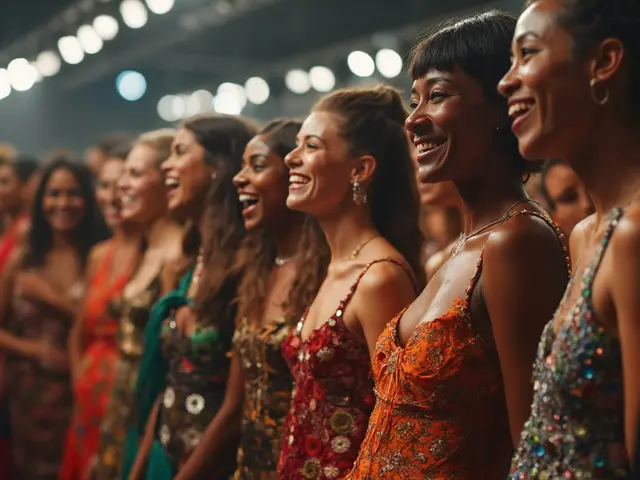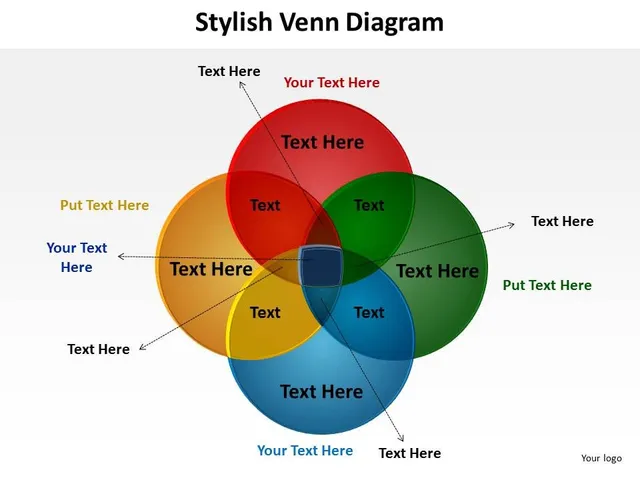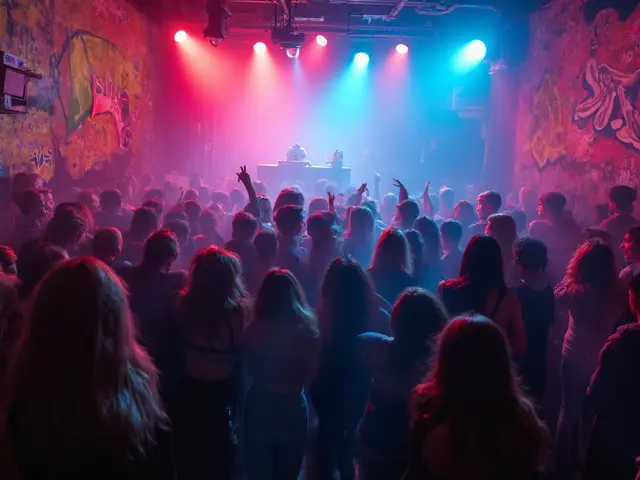You don’t need a front-row seat at Milan Fashion Week to feel the electric charge of supermodel magic. Ever zoomed into a Vogue cover and wondered what it takes to go from strutting in borrowed platform heels to becoming a global fashion phenomenon? The world of supermodels is messy, glamorous, sometimes ruthless—and always fascinating. These are the women who swap high school corridors for international runways, transform a walk into performance art, and turn their names into billion-dollar brands. Dive in, and you’ll see that being a supermodel isn’t just about the perfect photo or a killer walk. It's about changing culture, setting trends, and rewriting what beauty can be.
Definition and Context: What is a Supermodel and Why Do They Matter?
Brought up under blinding spotlights and growing up in magazines, supermodels are more than just faces—they’re living, breathing symbols of their eras. But let’s get honest: where did this wild idea of a “supermodel” even come from? The word didn’t just pop up one day. Sure, there were models long before, but it was only in the late ‘80s and ‘90s that a small circle—think Cindy Crawford, Naomi Campbell, Linda Evangelista—broke through to a new kind of fame. Suddenly, models weren’t nameless coat hangers for clothes; they had personalities, voices, bankable names. In some years, Naomi was recognized more than the President. Not exaggerating—by 1991, the most famous models were household names even in places where designer heels had never touched the ground.
So, what sets a supermodel apart from any other model? It’s that blend of charisma, versatility, and star power that leaves designers—and the entire planet—buzzing. The supermodel status isn’t just handed out. These women shoot campaigns with the likes of Versace and Chanel, then star in music videos, host Saturday Night Live, or appear in blockbuster films. Many become advocates for charity work and use their influence for real-world change. You won’t find two with the same story, but you will notice one thing they all share: they change the rules. When Gisele Bündchen brought back curves in the ‘00s—after years of ultra-skinny looks—she made $40 million in 2007 alone and became the world’s top-earning model for more than a decade. Claudia Schiffer, according to Forbes, appeared on more than 1,000 magazine covers. Try beating that high score.
And supermodels matter because they don’t just mirror culture; they push it forward. In 2018, Adwoa Aboah, born in the UK to a Ghanaian family, launched Gurls Talk, a movement supporting mental health and diversity in fashion. When Liu Wen became the first East Asian model to walk the Victoria’s Secret runway and to appear on Forbes’ highest-paid model list, doors flew open for a generation of new faces. Right now, the industry is being reshaped by broader definitions of beauty, thanks in part to the outspoken influence and hustle of these icons. The supermodel is more than a model—they're a cultural force.
Key Benefits: What Supermodels Bring to Fashion, Culture, and Beyond
Let’s bust the stereotype: supermodels aren’t just pretty faces. Their real magic is in how they move culture, fashion, and business forward at breakneck speed. You think those killer red carpet looks or new beauty standards came out of thin air? Nope. Much of today’s pop culture—who we admire, copy, or even envy—can be traced straight back to supermodels shaking things up. They’ve spun gold out of their careers in ways few industries manage.
Let’s break it down. First, supermodels bring legitimacy to brands. Remember the Versace Spring/Summer 2018 show when the ‘90s legends—Cindy, Naomi, Helena Christensen, Claudia Schiffer, Carla Bruni—strode out, recreating Donatella’s brother Gianni’s iconic finale? Instagram exploded. A photo from that moment spawned over 5 million posts in just weeks. Brands know: a supermodel’s involvement means instant cool. Collaborations between Bella Hadid and Dior, or Kate Moss and TopShop, transformed stretching collections into must-haves. Some even became creative directors, like Gigi Hadid’s line with Tommy Hilfiger, which sold out in hours.
Next, there’s the influence on beauty. For decades, high fashion dictated size-zero models, but supermodels have helped shake that up. Ashley Graham, one of the first plus-size models to cover Sports Illustrated’s Swimsuit Edition, proved that beauty in fashion isn’t one-size-fits-all. Today, more agencies and designers are opening their doors to different looks, backgrounds, and stories. Supermodels also bring social causes to the spotlight. Take Natalia Vodianova: she set up the Naked Heart Foundation, building playgrounds and promoting children’s welfare across Russia after growing up in poverty herself.
Supermodels have also changed what it means to be a businesswoman. Many parlay their fame into skincare lines, production companies, even healthy snacks (Miranda Kerr’s Kora Organics, Karlie Kloss’ vegan cookies). In 2024, Forbes revealed that the combined earning power of the top ten supermodels exceeded $180 million, with all of them investing in tech startups, sustainable fashion, or philanthropy. Want to think bigger? Some, like Tyra Banks, became multimedia moguls, hosting talk shows and launching “America’s Next Top Model,” which has over 150 syndicated versions worldwide.
Now, take a look at the diversity factor. For decades, runways lacked faces of color, but models like Iman and, more recently, Adut Akech, have flipped the script dramatically. In 2020, the Council of Fashion Designers of America made it mandatory to include models of all backgrounds for fashion week shows. Runways in Paris and New York now reflect the real world a little better, and it’s largely thanks to vocal supermodels leading the way.
Types of Supermodels and Global Trends
The phrase "supermodel" brings to mind a very specific image: long legs, chiseled cheekbones, wind blowing through perfectly tousled hair. But scratch beneath that surface, and you’ll find there are more flavors of supermodel than ever. Some fit the original ‘runway powerhouse’ type, owning haute couture events in Paris and Milan—think Naomi Campbell or Joan Smalls. Others are commercial superstars, starring in everything from Maybelline to Pepsi ads—think Gigi Hadid or Kendall Jenner. There are editorial supermodels, whose faces dominate magazine covers and high-fashion campaigns: Kate Moss still grabs this spot, decades into her career.
But 2025 is rewriting those categories. There’s a new league of social media supermodels. Their careers took off on TikTok or Instagram, not through elite agencies. Take Paloma Elsesser, who grew her fanbase online and became the face of Fenty Beauty (Rihanna’s billion-dollar line). Then you have multi-hyphenate models—those who act, sing, design, and more. Cara Delevingne moved from Burberry shoots to starring in TV series; Hailey Bieber went from runway to skincare entrepreneurship, clocking over 10 million products sold worldwide. Agencies like IMG and Elite have reported a 30% jump in signing models with huge online platforms over the past five years.
The new era has also seen the rise of “influencer-models,” who can make or break a trend overnight. Some are called the “digitally native supermodels.” Did you know that the virtual influencer Lil Miquela, a CGI character, has signed more contracts than hundreds of real-life models since 2022? That’s wild—and signals how the industry is transforming.
Outside the US and Europe, other supermodel scenes are booming. In China, Liu Wen and Ju Xiaowen have made Vogue China’s circulation soar to over a million. South Africa’s Precious Lee and Brazil’s Lais Ribeiro bring major international campaigns back to their home countries, using their platforms to champion local talents and designers. If you’re following trends, keep an eye on Africa and Latin America: international agencies set up scouting events there every month now, and viral catwalk clips from Lagos or São Paulo routinely rack up millions of views on TikTok.
One more twist: age isn’t the barrier it used to be. Maye Musk landed a major CoverGirl contract at 69, showing there’s no real expiration date if you have talent and the right attitude. Supermodels now come in every size, shape, color, age, and story. It’s way more dynamic, a breath of fresh air.
How to Become a Supermodel, Tips for Working in Fashion, and Iconic Career Facts
Ever secretly pictured yourself walking that glossy runway, flashbulbs popping, the whole world watching? Here’s the truth: breaking into the top tier isn’t about being “discovered” in a local mall anymore—or at least, not just that way. These days, most scouts scour not only events and local shows but also Instagram, TikTok, and the occasional high school graduation pic. Modeling agencies like IMG, Ford, and Elite get over 10,000 digital applications a year, with about 1% moving forward. That’s a smaller acceptance rate than Harvard.
If you’re looking to get started, here are some concrete steps: build a real, relatable online portfolio (no over-edited photos), tag brands and agencies, use professional hashtags like #newfaces, and stay consistent. Agencies want not just a "look" but personality and engagement—answer your DMs, show a sense of humor, run a book club, anything that sets you apart. Models who share their routines, talk openly about struggles, or show their passions (think Emily Ratajkowski’s political activism) get booked fast. Even experienced supermodels have to adapt; in 2023, Heidi Klum said that staying relevant meant daily interactions with fans and brands online.
For those lucky enough to sign, the journey’s just starting. Expect photoshoots at sunrise, endless traveling, constant competition. But here’s the upside: the earnings can be jaw-dropping. Gisele Bündchen’s net worth is over $400 million. Adriana Lima spent nearly 20 years as a Victoria’s Secret Angel, making up to $12 million a year at her peak, mostly from smart endorsements. Even in 2024, the top models pull in an average of $9 million yearly. Here’s a quick look at some iconic numbers:
| Supermodel | Peak Yearly Earnings | Major Collaborations | Years Active |
|---|---|---|---|
| Gisele Bündchen | $47 million | Victoria’s Secret, Chanel, Pantene | 1997–present |
| Kendall Jenner | $22.5 million | Estée Lauder, Calvin Klein, Adidas | 2015–present |
| Naomi Campbell | $10 million | Versace, Prada, Burberry | 1986–present |
| Adriana Lima | $12 million | Victoria’s Secret, Maybelline, IWC | 1999–present |
But it isn’t just about the paycheck. Being a supermodel means balancing a tightrope of competition, staying healthy, surviving constant travel, and coping with criticism. Most train in fitness, nutrition, and mental health resilience. Some even take business courses—Karlie Kloss famously went to coding camp and ran a scholarship fund for girls in tech.
Want to stand out? Learn the art of the walk (YouTube is packed with tutorials). Know your go-tos (Naomi’s "walk of doom" is legendary for a reason). Focus on versatility—Vittoria Ceretti, for instance, went from Prada campaigns to sustainability activism. Try to specialize in a niche—fitness, commercial, editorial—and be ready to pivot. The era of just “standing and looking pretty” is over. These days, you might just launch with a viral TikTok—then co-host a Met Gala live stream next spring!
If you’re considering the path, one key tip: be cautious about industry scams or shady offers. Real agencies never ask for thousands up front or push risky side gigs. Talk to established models or agencies, check for reviews, stick to reputable names. If you’re under 18, always have a parent or guardian involved in any contract talks. Protecting your boundaries is part of the job now.
So, if you’re inspired, here’s your start—create, connect, stay grounded, and know the world will be watching. Fame, fortune, and influence might come—just remember that what made the big names icons wasn’t just beauty, it was resilience, wits, and a willingness to rewrite the rules. That’s the real power of the supermodels who go from catwalk to icon.



